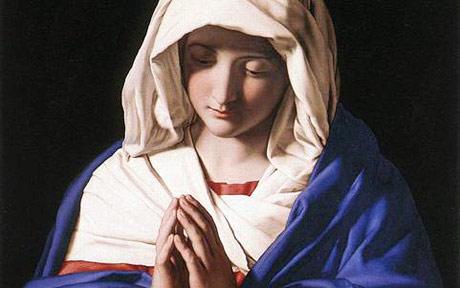By Alastair Jamieson
The London Telegraph Newspaper
Last Updated: 9:57PM BST 28 Sep 2008
Comments 25
| Comment
on this article

Sassoferrato's 17th Century Virgin Mary
Research at Oxford University has found believers can draw on their
religion to endure suffering with greater fortitude, suggesting Christian
martyrs may have been able to reduce the agony of torture or slow death.
Academics at The Oxford Centre For Science Of The Mind gave electric
shocks to 12 Roman Catholics and 12 atheists as they studied a painting of
the Virgin Mary.
They found Catholics seemed able to block out much of the pain. Using
brain-scanning techniques, they also discovered that the Catholics were
able to activate part of the brain associated with conditioning the
experience of pain.
The experiment is one of a series being conducted by the academics, a
group of scientists, philosophers and theologians from different
departments at the university.
A sparking device was strapped to the back of the participants' left
hands to deliver an electric shock.
The scientists then asked them to contemplate two paintings,
Sassoferrato's 17th Century Virgin Mary and Leonardo da Vinci's 15th
Century Lady With An Ermine.
The researchers hoped that the face of the Virgin Mary would induce a
religious state of mind in the believers, while da Vinci's secular
painting was chosen because it did not look dissimilar and would be
calming.
They spent half an hour inside an MRI scanner, receiving a series of 20
electric shocks in four separate sessions while looking at either the
religious or non-religious picture.
The Catholics said that looking at the painting of the Virgin Mary made
them feel 'safe', 'taken care of' and 'calmed down and peaceful'.
More significantly, they reported feeling 12 per cent less pain after
viewing the religious image than after looking at the Leonardo.
The front right-hand side of their brains lit up on the scanner,
indicating that the neural mechanisms of pain modulation had been engaged.
There was no such brain activity among the atheists, whose pain and
anxiety levels stayed roughly the same throughout the experiment.
Writing in the scientific journal Pain, the researchers concluded that
at least some religious believers can moderate their pain by thinking
about it more positively.
Psychologist Miguel Farias, one of the team, admitted that a similar
effect may be produced by non-believers if a sufficiently powerful image
was used.
He said: "We would need to find a picture of someone they feel
very positive towards, such as a mother or father."
The Anglican Bishop of Durham, the Rt Rev Tom Wright, welcomed the
findings. He said: "The practice of faith should, and in many cases
does, alter the person you are.
"It can affect the patterns of your brain and your emotions. So it
comes as no surprise to me that this experiment has reached such
conclusions."